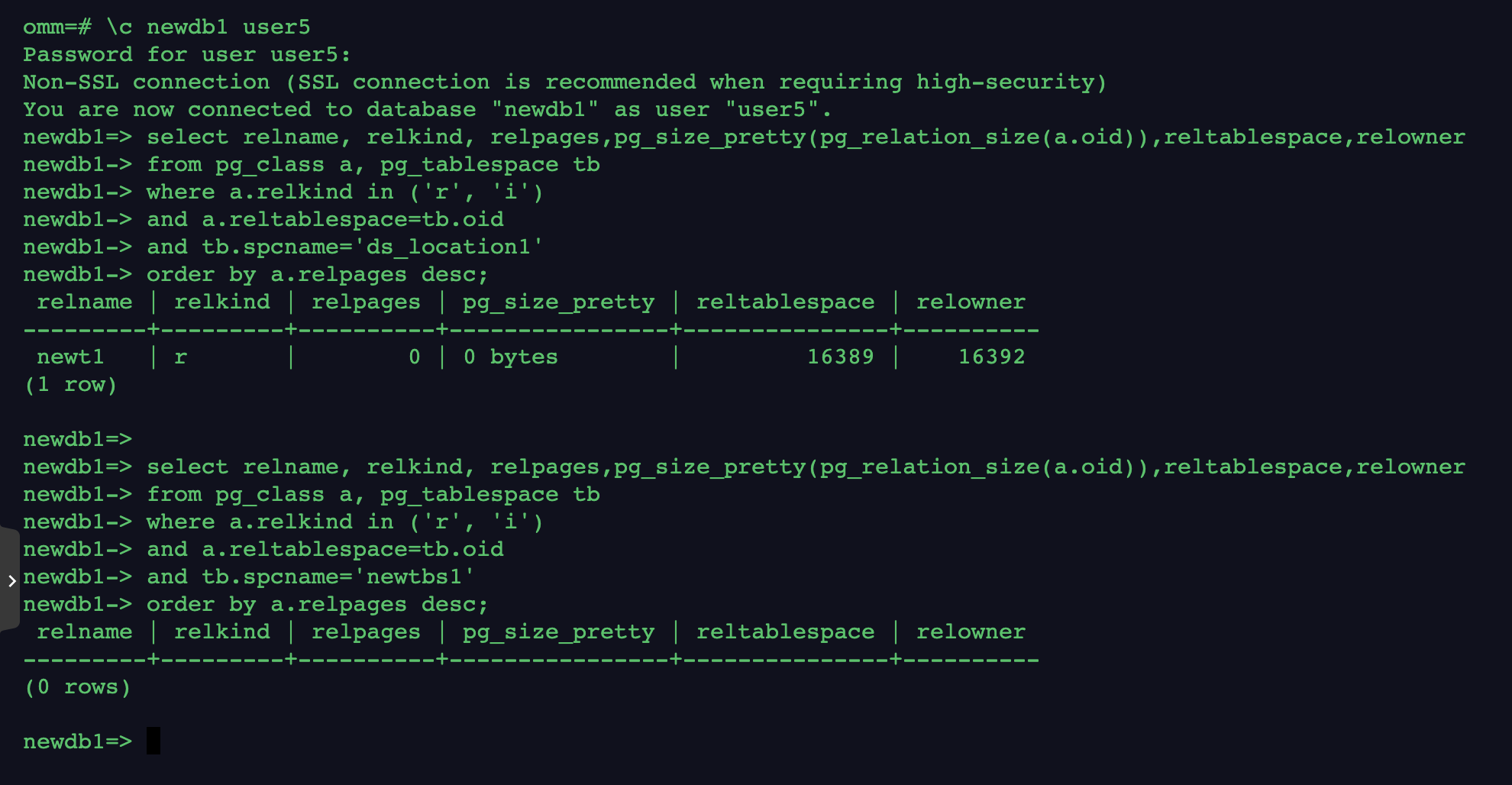学习目标
学习表空间与数据库对象的关系。
在musicdb数据库中创建的所有的表,没有指定表空间的名字,因此都创建在数据库默认的表空间music_tbs中,当我们在musicdb数据库中创建表warehouse_t1的时候,明确指定在表空间ds_location1中创建时,这个表会存储在这个指定的表空间。即一个数据库中的对象,可以位于不同的表空间.
课程学习
1.连接数据库,准备测试环境
#第一次进入等待15秒
#数据库启动中...
su - omm
gsql -r
--进入数据库omm,创建表空间、测试数据库
drop DATABASE IF EXISTS musicdb;
drop DATABASE IF EXISTS musicdb1;
drop DATABASE IF EXISTS musicdb2;
drop DATABASE IF EXISTS musicdb3;
drop tablespace IF EXISTS music_tbs;
CREATE TABLESPACE music_tbs RELATIVE LOCATION 'tablespace/test_ts1';
CREATE DATABASE musicdb WITH TABLESPACE = music_tbs;
--执行下面的SQL语句,创建用户user1:
CREATE USER user1 IDENTIFIED BY 'kunpeng@1234';
--授予user1数据库系统的SYSADMIN权限:
ALTER USER user1 SYSADMIN;
2.创建表空间、查看表空间
--执行下面的命令,查看当前表空间:
\db
--创建一个新的名为ds_location1的表空间:
CREATE TABLESPACE ds_location1 RELATIVE LOCATION 'tablespace/tablespace_1';
--执行下面的命令,查看实例当前有哪些表空间:
\db
3.使用user1用户,访问musicdb数据库 ,在表空间ds_location1上创建表warehouse_t1:
\c musicdb user1
create table warehouse_t1 (col1 char(10)) tablespace ds_location1;
4.查看musicdb数据库目前有哪些表:
select table_catalog, table_schema, table_name, table_type from information_schema.tableswhere table_schema not in ('pg_catalog', 'information_schema','dbe_perf');
5.查询表在那个表空间
--建表warehouse_t1指定表空间ds_location1,查看表warehouse_t1所在的表空间:
select * from pg_tables where tablename = 'warehouse_t1';
--创建表warehouse_t12未指定表空间,则在默认表空间(不显示默认表空间名)
create table warehouse_t12 (col1 char(10));
select * from pg_tables where tablename = 'warehouse_t12';
6.查看openGuass数据库的默认表空间
select datname,dattablespace,spcname from pg_database d, pg_tablespace t where d.dattablespace=t.oid;
7.查询数据库的默认表空间上的对象
select relname, relkind, relpages,pg_size_pretty(pg_relation_size(a.oid)),reltablespace,relowner
from pg_class a
where a.relkind in ('r', 'i')
and reltablespace='0'
order by a.relpages desc;
8.查询表空间ds_location1上的对像
\c musicdb user1
select relname, relkind, relpages,pg_size_pretty(pg_relation_size(a.oid)),reltablespace,relowner
from pg_class a, pg_tablespace tb
where a.relkind in ('r', 'i')
and a.reltablespace=tb.oid
and tb.spcname='ds_location1'
order by a.relpages desc;
课后作业
1.创建表空间newtbs1、 ds_location1,查看表空间
Linux下,切换到omm用户,执行gslq命令登录数据库,执行以下语句创建表空间。
--执行下面的命令,查看当前表空间:
\db
--创建两个新的名为ds_location1和newtbs1的表空间:
CREATE TABLESPACE ds_location1 RELATIVE LOCATION 'tablespace/tablespace_1';
CREATE TABLESPACE newtbs1 RELATIVE LOCATION 'tablespace/tablespace_2';
--执行下面的命令,查看实例当前有哪些表空间:
\db
2.创建一个数据库newdb1,默认表空间为newtbs1
--执行下面的命令,查看当前有哪些数据库和表空间:
\l
\db
--创建一个数据库newdb1,默认表空间为newtbs1:
CREATE DATABASE newdb1 with TABLESPACE = newtbs1;
--执行下面的命令,查看实例当前有哪些数据库:
\l
3.创建用户user5,并授予SYSADMIN权限,访问数据库newdb1,在表空间ds_location1上,创建一个表newt1(表结构自定义)
--执行下面的SQL语句,创建用户user5:
CREATE USER user5 IDENTIFIED BY 'kunpeng@1234';
--授予user5数据库系统的SYSADMIN权限:
ALTER USER user5 SYSADMIN;
--使用user5用户,访问newdb1数据库 ,在表空间ds_location1上创建表newt1:
\c newdb1 user5
create table newt1 (col1 char(10)) tablespace ds_location1;
4.查看表所在的表空间
执行以下语句后,可以看出,newt1表所在的表空间为建表时指定的表空间ds_location1。
--建表newt1指定表空间ds_location1后,查看表newt1所在的表空间:
select * from pg_tables where tablename = 'newt1';
5.查看表空间newtbs1、 ds_location1上的对象
执行以下语句,可以看到ds_location1表空间中存在表newt1对象,而newtbs1中无对象存在,可以看出,在openGauss中,明确指定在表空间ds_location1中创建对象时,这个对象会存储在这个指定的表空间。即一个数据库中的对象,可以位于不同的表空间。
\c newdb1 user5
select relname, relkind, relpages,pg_size_pretty(pg_relation_size(a.oid)),reltablespace,relowner
from pg_class a, pg_tablespace tb
where a.relkind in ('r', 'i')
and a.reltablespace=tb.oid
and tb.spcname='ds_location1'
order by a.relpages desc;
select relname, relkind, relpages,pg_size_pretty(pg_relation_size(a.oid)),reltablespace,relowner
from pg_class a, pg_tablespace tb
where a.relkind in ('r', 'i')
and a.reltablespace=tb.oid
and tb.spcname='newtbs1'
order by a.relpages desc;






